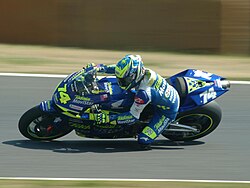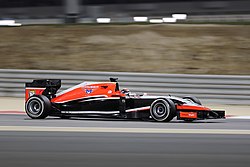| Driver | Date | Vehicle | Entrant | Section | Type | Event | Cause |
|---|
 Masao Asano Masao Asano | 4 May 1963 [ ja ] | Austin-Healey 3000 | | 130R | Car | Japanese Grand Prix | As Asano approached 130R, he crashed into the guardrail, throwing him clear of the car suffering a severe head injury. He died in hospital three months later. [3] [4] |
|
 Tojiro Ukiya [ ja ] Tojiro Ukiya [ ja ] | 20 August 1965 | Dome Karasu | | 130R | Car | Testing | While avoiding two spectators who were walking on the course, Ukiya swerved but crashed into a lamppost. He was thrown off his car, suffering head injury and fracturing both legs and died in hospital 21 days later. [3] [5] The car is believed to be a Dome Karasu, a rebodied S600 and was the first car to be built by Dome. [6] |
|
 Takeshi Mitsuno Takeshi Mitsuno | 10 October 1965 | Honda S600 | | | Car | Suzuka KSCC race meeting | [3] [7] |
|
 Takashi Matsunaga Takashi Matsunaga | 10 August 1969 | Honda R1300 | Honda | Spoon Curve | Car | Suzuka 12 Hours race | As Matsunaga was about to stop to refuel, he crashed into a guardrail, causing the car to explode into a fireball. He was taken into hospital where he died 25 days later on 4 September [3] [8] |
|
 Kiyoshi Akiyama Kiyoshi Akiyama | 23 August 1970 | Honda S800 | | Spoon Curve | Car | Suzuka 12 Hours race | Akiyama's Honda S800 struck Hiromi Nishino's Isuzu Bellett at Spoon corner, causing the two cars to explode into a fireball, burning 150 liters of gasoline. While Nishino managed to escape with the aid of marshals, Akiyama remained in the burning car about 15 minutes. He later died of extensive burns. [9] [10] |
|
 Satoru Takashima Satoru Takashima | 8 August 1970 | | | Degner | Motorcycle | Suzuka 10 Hours Production | During a Saturday qualifying session, 20-year-old newcomer Takashima went straight on at the Degner bend and flew over the guardrails, sustaining severe head and chest injuries. He was transferred to hospital where he succumbed to head injuries shortly afterwards, specifically basilar skull fracture. [11] [12] |
|
 Minoru Kawai [ ja ] Minoru Kawai [ ja ] | 26 August 1970 | Toyota 7 | Toyota | Degner | Car | Testing | Kawai lost control of the Toyota 7 at the Degner bend at about 200 km/h, being thrown out of the car. He sustained a basal skull fracture and two broken legs, and was immediately taken to hospital by ambulance. About 30 minutes later he died of his injuries. [9] [13] [14] |
|
 Senkichi Omura Senkichi Omura | 7 April 1974 | Brabham BT21 | | Spoon | Car | F2000 private test | Omura crashed into a guardrail, and was killed on impact by a broken neck. [9] |
|
 Shoji Iso Shoji Iso | 6 March 1982 | | | 1st Curve | Car | All-Japan Formula Three Championship practice | Iso's car spun on the 1st Curve and stopped on the grass. While he was walking away, he was struck by another car, killing him instantly. [15] [16] |
|
 Kengo Kiyama Kengo Kiyama | 10 June 1983 | | | Spoon | Motorcycle | 200 km of Suzuka qualifying | While approaching the Spoon curve, Kiyama crashed and was killed instantly. [17] |
|
 Kunio Katsumata Kunio Katsumata | 30 July 1983 | | | | Motorcycle | Suzuka 8 Hours qualifying | [18] |
|
 Hitoshi Ogawa Hitoshi Ogawa | 24 May 1992 | Lola T92/50 - Mugen Honda | Team Cerumo | First Corner | Car | Japanese Formula 3000 race | Ogawa attempted to overtake Andrew Gilbert-Scott's car on the main straight but Gilbert-Scott held his position. As Ogawa moved to the side of Gilbert-Scott's car he hit its left-rear wheel and the cars became entangled. The two of them travelled down the straight at speed and off into the gravel trap. Gilbert-Scott's car spun while Ogawa's car went in nose-first. Gilbert-Scott's car hit the tyre wall and flipped, landing upside down. However, Ogawa hit a mound and went over the tyre barrier, hitting a high-fence supporting pole with violent force. Both cars were completely destroyed in the accident and the race was immediately stopped. One cameraman, several photographers, and Gilbert-Scott were all injured. Ogawa was freed from his wrecked Team Cerumo Lola, but had suffered severe leg, head and neck injuries during the crash. He died on the way to a hospital. [19] |
|
 Elmo Langley Elmo Langley | 21 November 1996 | Chevrolet Corvette | Safety Car | S-Curve | Car | NASCAR Thunder 100 | NASCAR official and safety car driver Langley suffered a heart attack during safety car runs for the NASCAR exhibition race and stopped in the S-Curve. He was the first person from outside Japan to die at the circuit. [20] [21] |
|
 Naoto Ogura Naoto Ogura | 7 March 2000 | Suzuki Hayabusa | Yoshimura | 200R | Motorcycle | Testing | Ogura crashed into a barrier on the outside of 200R (between the hairpin and Spoon), where he was taken to hospital and eventually died from his injuries. Motorcycles no longer use 200R after 2004 revisions added a chicane. [22] |
|
 Mamoru Yamakawa Mamoru Yamakawa | 30 July 2000 | Kawasaki Ninja ZX-9R | Challenge of Yamakawa | 130R | Motorcycle | Suzuka 8 Hours race | Yamakawa lost control of his Kawasaki after failing to negotiate 130R and crashed into the cushioned barriers. He was dead on arrival. It was the first of a few major incidents in various classes of motorsport at 130R, leading it to be reprofiled for 2003. [23] [24] [25] |
|
 Daijiro Kato Daijiro Kato | 20 April 2003 | Honda RC211V | Gresini Racing | Between 340R and Casio Triangle | Motorcycle | Japanese motorcycle Grand Prix race | Exiting the 85R/340R double-apex (formerly 130R, a reference to the 130m radius curve prior to the 2003 revisions) on Lap 3, Kato high-sided on the straight exiting 340R, braking for the Casio Triangle. He struck the wall at around 125 mph (200 km/h), and was thrown back onto the track. [1] Rather than waving a red flag to allow the race to be stopped so the track could be safely cleared, corner workers dragged Kato's body off the track and threw him on a stretcher. The race was not stopped. Kato spent two weeks in a coma before dying as a result of the injuries he sustained. The cause of death was listed as brain stem infarction. The Japanese Motorcycle Grand Prix has not been held at Suzuka since. [2] |
|
 Keisuke Sato Keisuke Sato | 12 June 2005 | Honda CBR600RR | | Second Corner | Motorcycle | 200 km of Suzuka qualifying | On the last lap of a qualifying session for a 200-kilometer race, Sato lost control of his bike when he attempted to swerve around a pool of fuel left on the track that had not been cleaned after another accident involving two other competitors causing him to run off the road and hit a safety barrier, causing him fatal thoracic injuries. [26] [27] |
|
|
 Osamu Nakajima Osamu Nakajima | 21 October 2012 | Nissan 350Z | Rire Racing & LeyJun | First Corner | Car | WTCC Race of Japan
Super Taikyu Series support race | Nakajima's car slipped on oil from a previous incident at the first corner on lap 11. He slid off the road and hit the wall, resulting in fatal injuries. The race was stopped, and no champagne was sprayed during winner's ceremonies for the feature race. Nakajima died as a result of a basilar skull fracture from not wearing an FIA-certified frontal head restraint (FHR), leading to Super Taiku mandating an FIA-certified frontal head restraint as a result. The weekend, which the race was supporting the 2012 FIA WTCC Race of Japan, also saw the death of an unnamed guest of SunRed Engineering, who fell from the second floor of the stands above Arena Motorsport and Special Tuning Racing. [28] |
|
|
 Jules Bianchi Jules Bianchi | 5 October 2014 | Marussia MR03 | Marussia F1 | Dunlop Corner | Car | Japanese Grand Prix | On lap 42 of the Grand Prix, Adrian Sutil had spun into the runoff area at Dunlop Corner, in heavy rain, and a crane tractor was deployed to attend to his car. Afterwards, with only Dunlop Corner under yellow but the rest of the track still under green, Bianchi collided at high speed with the tractor, knocking him unconscious. He was taken to a hospital, where a CT scan revealed that he had suffered a "severe head injury". Flown to France for further treatment, he never regained consciousness, and died of his injuries on 17 July 2015 in Nice, France. The FIA made administrative race changes following the crash. [29] The Bianchi family began legal proceedings against Manor Racing the current owners of the then Marussia F1, Honda Motor Company's Mobilityland owners of the Suzuka Circuit, Suzuka City, Mie Prefecture, Kansai region, Formula One Group, and the FIA, in relation to his death. [30] |
|
|

